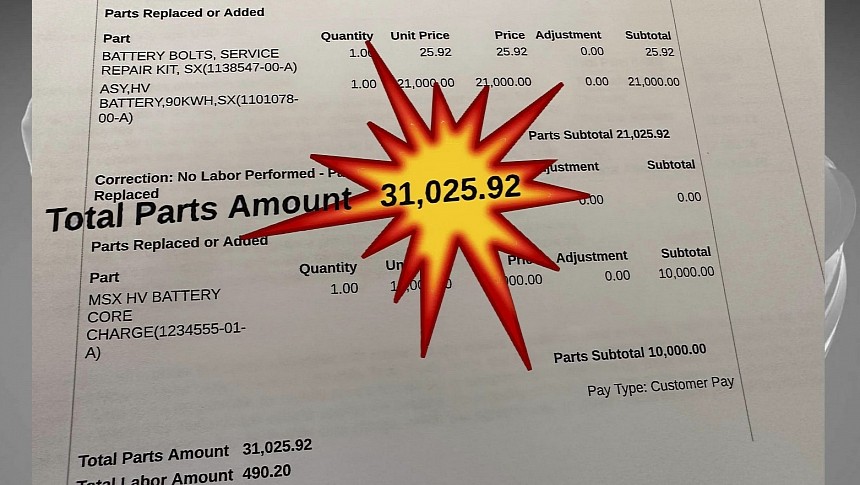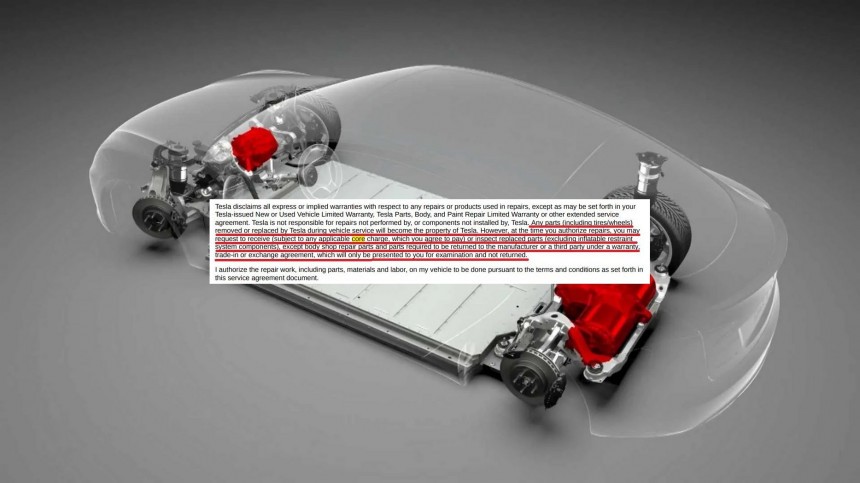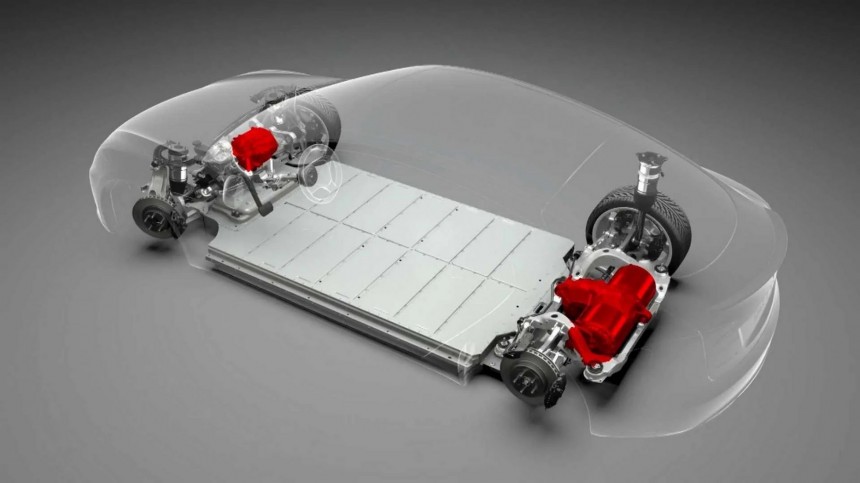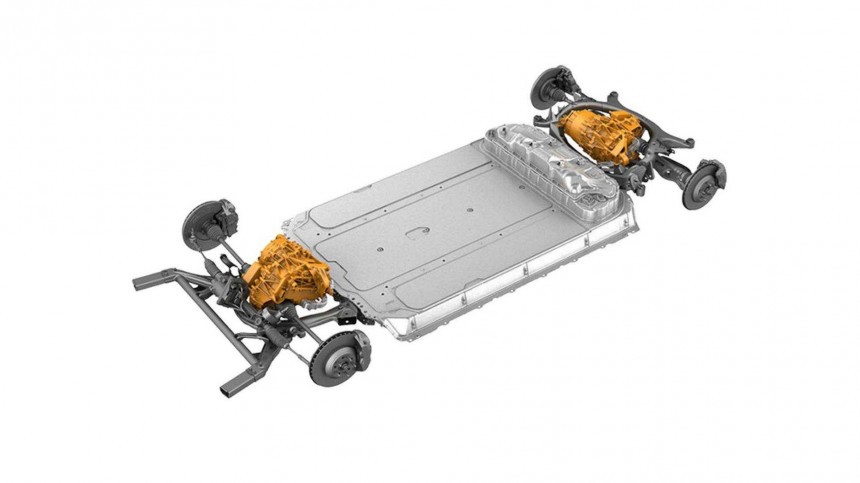When I wrote about battery electric vehicle (BEV) repairs in May, I talked about battery packs and missed something crucial that only a recent estimate made me see. This document came from a customer who demanded to keep his old battery pack from Tesla after replacing it. The BEV maker then provided him with an estimate. The final bill was $31,025.92 just for parts. In other words, it would be a mistake to consider the component costs only $21,000. It only costs that much because the old piece makes it cheaper.
In my previous article, I tried to discuss if Tesla's policy of keeping old parts was legal. The BEV maker puts a disclaimer at the end of all its estimates that clarifies its policy for replaced components:
"Any parts (including tires/wheels) removed or replaced by Tesla during vehicle service will become the property of Tesla. However, at the time you authorize repairs, you may request to receive (subject to any applicable core charge, which you agree to pay) or inspect replaced parts (excluding inflatable restraint system components), except body shop repair parts and parts required to be returned to the manufacturer or a third party under a warranty, trade-in or exchange agreement, which will only be presented to you for examination and not returned."
As you can see, Tesla gets to keep everything it replaces, which is not how some places say things should be. New York's Repair Shop Act states that customers can have all replaced parts back. The only exceptions are warranty and exchange parts. In the first case, it is the automaker that pays for the replaced components, so that is only fair. Recalled components must also be included here not only due to the hazard they present but also because they are paid by the automaker or the supplier.
In the second, exchange parts are legally defined as those provided by a supplier to replace any unserviceable component or to speed up the repair process. A crucial aspect of these components is that they are cheaper because the previous part helps to pay for its costs. In other words, the old piece has economic value because it may be recovered to become an exchange part itself.
That all would make Tesla's battery packs fit the description of exchange parts if it were not for an essential aspect of the deal: Tesla does not disclose how much the used battery pack is worth when it sells you a new or remanufactured one. However, owners who demand to keep it have to pay a core charge of $10,000, regardless of the state of the replaced component. That value appears in the estimate I mentioned and in several other cases.
Bob Atkins faced that when his mother-in-law's Model S needed a battery pack replacement. It was affected by the infamous BMS_u029 error code, and Atkins fought to get a new battery pack instead of the remanufactured unit Tesla installed. He also wondered about keeping the old component, and the BEV maker said it would cost him $10,000.
Donald Bone received the same core charge when Tesla told him he would have to replace the battery pack in his Model 3 due to a broken coolant nipple in July 2021. If he didn't keep the old battery pack, he would have had to pay $16,000. In other words, the new component would cost $26,000 if the old one did not help him pay the bill. The Electrified Garage fixed that for $700.
That means a battery pack replacement at Tesla is the price the company asks in estimates, plus the core charge the customer would have to pay if they wanted to keep the old component. These prices range from $23,500 to $31,000 – without labor or taxes. That considers the costs of remanufactured battery packs ($13,500) and new 90-kWh components ($21,000), as well as the core charge for the used ones ($10,000). This is a mandatory value whenever someone needs to calculate how much a battery pack is worth. You may also consider these components as exchange parts from now on, even if Tesla does not make it clear.
That completely changes how you should evaluate a used Tesla – or any electric car with large battery packs. A 24-kWh battery pack for a 2014 Nissan LEAF got an estimate of €30,000 ($31,977 at the current exchange rate) in Portugal in 2019. The 18.1-kWh battery pack on a Toyota RAV4 Prime will set you back $10,000 to $12,000 if it needs to be replaced. If the high-voltage accumulator may be a massive financial burden even in plug-in hybrid vehicles, that's especially true for older BEVs.
Who will risk buying a used electric car that is worth less than $30,000 when its battery pack may cost more than that right from the start? That reminds me of the notorious story of Tuomas Katainen. He is the Finnish customer who purchased a 2013 Model S in 2021 and decided to blow it up and film the whole thing after receiving a repair estimate that the repair probably cost more than his BEV to have it repaired.
Depreciation is already hitting used cars pretty hard without the need to replace their battery packs, which will probably become an issue after their eight-year warranties start to expire. Only Tesla and Nissan have BEVs that are old enough for us to measure that, but that will not take long to change. Suppose a battery pack is damaged beyond repair and ceases to be a suitable exchange part. The repair bill will come with the actual cost of this component instead of the one the damaged battery pack could help to make less scary.
At these prices, battery packs will turn all BEVs that cost less than $30,000 into disposable cars. It will not pay off to fix them. Old battery packs will only do that for a limited time, always with the risk that these parts will fail sooner than a new one would. It is time we get serious and responsibly discuss these perspectives instead of just pushing for a future in which all cars will have crucial components that will always cost more than they do.
"Any parts (including tires/wheels) removed or replaced by Tesla during vehicle service will become the property of Tesla. However, at the time you authorize repairs, you may request to receive (subject to any applicable core charge, which you agree to pay) or inspect replaced parts (excluding inflatable restraint system components), except body shop repair parts and parts required to be returned to the manufacturer or a third party under a warranty, trade-in or exchange agreement, which will only be presented to you for examination and not returned."
As you can see, Tesla gets to keep everything it replaces, which is not how some places say things should be. New York's Repair Shop Act states that customers can have all replaced parts back. The only exceptions are warranty and exchange parts. In the first case, it is the automaker that pays for the replaced components, so that is only fair. Recalled components must also be included here not only due to the hazard they present but also because they are paid by the automaker or the supplier.
That all would make Tesla's battery packs fit the description of exchange parts if it were not for an essential aspect of the deal: Tesla does not disclose how much the used battery pack is worth when it sells you a new or remanufactured one. However, owners who demand to keep it have to pay a core charge of $10,000, regardless of the state of the replaced component. That value appears in the estimate I mentioned and in several other cases.
Bob Atkins faced that when his mother-in-law's Model S needed a battery pack replacement. It was affected by the infamous BMS_u029 error code, and Atkins fought to get a new battery pack instead of the remanufactured unit Tesla installed. He also wondered about keeping the old component, and the BEV maker said it would cost him $10,000.
That means a battery pack replacement at Tesla is the price the company asks in estimates, plus the core charge the customer would have to pay if they wanted to keep the old component. These prices range from $23,500 to $31,000 – without labor or taxes. That considers the costs of remanufactured battery packs ($13,500) and new 90-kWh components ($21,000), as well as the core charge for the used ones ($10,000). This is a mandatory value whenever someone needs to calculate how much a battery pack is worth. You may also consider these components as exchange parts from now on, even if Tesla does not make it clear.
That completely changes how you should evaluate a used Tesla – or any electric car with large battery packs. A 24-kWh battery pack for a 2014 Nissan LEAF got an estimate of €30,000 ($31,977 at the current exchange rate) in Portugal in 2019. The 18.1-kWh battery pack on a Toyota RAV4 Prime will set you back $10,000 to $12,000 if it needs to be replaced. If the high-voltage accumulator may be a massive financial burden even in plug-in hybrid vehicles, that's especially true for older BEVs.
Depreciation is already hitting used cars pretty hard without the need to replace their battery packs, which will probably become an issue after their eight-year warranties start to expire. Only Tesla and Nissan have BEVs that are old enough for us to measure that, but that will not take long to change. Suppose a battery pack is damaged beyond repair and ceases to be a suitable exchange part. The repair bill will come with the actual cost of this component instead of the one the damaged battery pack could help to make less scary.
At these prices, battery packs will turn all BEVs that cost less than $30,000 into disposable cars. It will not pay off to fix them. Old battery packs will only do that for a limited time, always with the risk that these parts will fail sooner than a new one would. It is time we get serious and responsibly discuss these perspectives instead of just pushing for a future in which all cars will have crucial components that will always cost more than they do.













